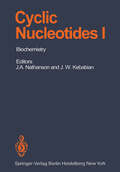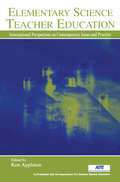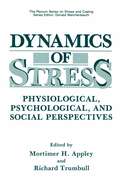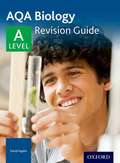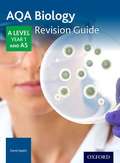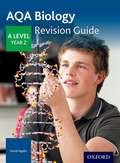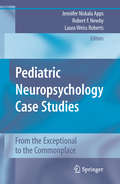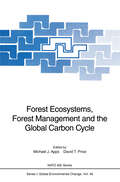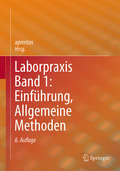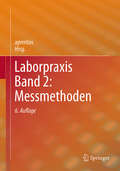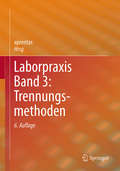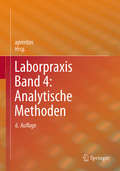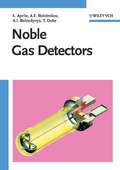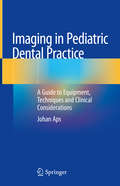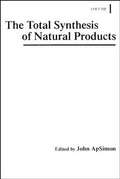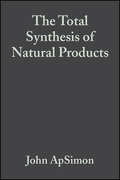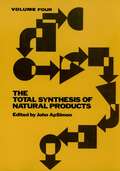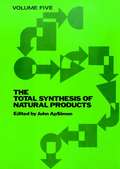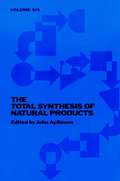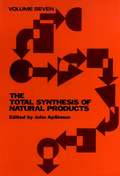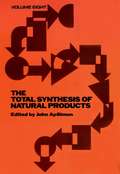- Table View
- List View
Cyclic Nucleotides: Part I: Biochemistry (Handbook of Experimental Pharmacology #58 / 1)
by M. M. Appleman M. A. Ariano J. A. Beavo L. Birnbaumer G. Brooker W. Y. Cheung P. Greengard T. K. Harden J. F. Harper R. Iyengar E. M. Johnson C. L. Kapoor J. F. Kuo C. K. Mittal M. C. Mumby F. Murad J. P. Perkins T. W. Rall G. R. Revankar R. K. Robins H. Schulman M. Shoji A. Steiner D. R. Storm D. J. Takemoto U. Walter R. H. WhitsonThe purpose of the present volume, the first of two on the pharmacology, biochemistry, and physiology of cyclic nucleotides, is to provide a comprehensive and up-to-date anthology on the nature and role of these important chemical regulators. Each of the chapters is the work of internationally known researchers who present a lucid and detailed review of their subject and not merely a single laboratory's viewpoint. The chapters emphasize critical assessments of the field rather than mere listings of experimental findings. By so doing, the contributors present the role of cyclic nucleotides in relationship to other intracellular regulators. Each chapter begins with a detailed summary to allow the reader to obtain a rapid overview of subsequent material. In addition, there are extensive bibliographies and a detailed subject index. Wherever pertinent, the chapters contain sections on drug mechanisms, physiological relevance, and disease processes. The Volume is divided into two sections, each beginning with an overview written by Professors T. W. RALL and P. GREENGARD, respectively. The first section focuses on the detailed pharmacology and chemistry of cyclic nucleotides, including their formation, degradation, measurement, and interaction with various modulatory agents, such as receptors and calcium. The second section is concerned with the biochemistry of protein phosphorylation, a process which appears to be one of the most important mechanisms for the intracellular expression of cyclic nucleotide action in eukaryotic cells.
Elementary Science Teacher Education: International Perspectives on Contemporary Issues and Practice
by Ken AppletonCo-Published with the Association For Science Teacher Education. Reflecting recent policy and standards initiatives, emerging research agendas, and key innovations, this volume provides a contemporary overview of important developments and issues that have that have in recent years shaped elementary science education pre-service courses and professional development, and practices that are shaping future directions in the field. Contributors from several countries who are actively engaged in research and design in elementary science education address:*Conceptual issues which impinge on contemporary science teacher education;*Intersections of content, pedagogy, and practice; and*Professional development as a contextualized practice.Elementary Science Teacher Education: International Perspectives on Contemporary Issues and Practice offers a clear picture of the current state of the field and directions for the future--to the benefit of elementary science teacher educators, aspiring teacher educators, school policy makers, other professionals involved in science education and, ultimately, the millions of elementary school children who will gain from improved practice.
Elementary Science Teacher Education: International Perspectives on Contemporary Issues and Practice
by Ken AppletonCo-Published with the Association For Science Teacher Education. Reflecting recent policy and standards initiatives, emerging research agendas, and key innovations, this volume provides a contemporary overview of important developments and issues that have that have in recent years shaped elementary science education pre-service courses and professional development, and practices that are shaping future directions in the field. Contributors from several countries who are actively engaged in research and design in elementary science education address:*Conceptual issues which impinge on contemporary science teacher education;*Intersections of content, pedagogy, and practice; and*Professional development as a contextualized practice.Elementary Science Teacher Education: International Perspectives on Contemporary Issues and Practice offers a clear picture of the current state of the field and directions for the future--to the benefit of elementary science teacher educators, aspiring teacher educators, school policy makers, other professionals involved in science education and, ultimately, the millions of elementary school children who will gain from improved practice.
Dynamics of Stress: Physiological, Psychological and Social Perspectives (Springer Series on Stress and Coping)
by Mortimer H. Appley Richard A. TrumbullIt was our privilege, some twenty years ago, to assemble a group of Canadian and American investigators to examine the status of research in the then newly burgeoning field of psychological stress (Appley & Trumbull, 1967). As noted, in Chapter 1 of the present volume, there has been rapid development of the area since then. The conference on which the current volume is based was designed to do three things: 1. to further update the field, 2. to bring European and other perspectives to the subject, and 3. to focus on the status of theory of stress. We believe the reader will agree that all three objectives were accom plished, though in so vast and active a field, one can never be totally satisfied. The authors included in this volume are among the leading inves tigators in the field. They represent active research centers and programs in Austria, East and West Germany, Great Britain, Israel, Sweden, and the United States. Their chapters make contributions to stress theory and methodology, inform us meaningfully of the perspectives of the various research programs they represent, and provide, collectively, a description of the dynamics of the stress process as currently emerging.
Aqa A Level Biology Revision Guide
by David ApplinPlease note this title is suitable for any student studying:Exam Board: AQA Level: A Level Subject: Biology First teaching: September 2015 First exams: June 2017The AQA A Level Biology Revision Guide is fully revised and updated for the new 2015 specification. Exactly matched to the specification, the Revision Guide provides comprehensive, specification-linked content, so you can be sure you are covering everything you need to know for the exams. It is packed with engaging revision and practice material to keep you focused and contains a wealth of exam-style questions to test your knowledge and skills to help you fully prepare for theexams.
AQA A Level Biology Year 1 Revision Guide
by David ApplinThe AQA A Level Biology Revision Guide provides comprehensive, specification-matched content, packed with engaging revision and practice material to keep you focused. It also contains a wealth of exam-style questions to test your knowledge and skills to help you fully prepare for the exams.
Aqa A Level Biology Year 2 Revision Guide
by David ApplinPlease note this title is suitable for any student studying:Exam Board: AQA Level: A Level Year 2Subject: BiologyFirst teaching: September 2015 First exams: June 2017The AQA A Level Biology Revision Guide is fully revised and updated for the new 2015 specification. Exactly matched to the specification, the Revision Guide provides comprehensive, specification-linked content, so you can be sure you are covering everything you need to know for the exams. It is packed with engaging revision and practice material to keep you focused and contains a wealth of exam-style questions to test your knowledge and skills to help you fully prepare for theexams.
Pediatric Neuropsychology Case Studies: From the Exceptional to the Commonplace
by Jennifer Niskala Apps Robert F. Newby Laura Weiss RobertsIn the recent literature, the most influential case study books in neuropsychology are in the adult realm. Pediatric neuropsychology is a rapidly developing field with increasingly greater influence in the assessment, diagnosis, early identification, and treatment of childhood illnesses. This book will provide the first centralized, comprehensive resource for case studies in pediatric neuropsychology. Not only will this supply a valuable compilation for the growing numbers of professionals in this field, but will also serve as an innovative and appealing resource for therapists, teachers, and others interested in child development. This book will be structured in such a way that readers can easily access individual cases of interest, as well as related areas of dysfunction. Section breakdowns will be provided in order to highlight the combined focus of case presentations in acquired neuropsychological dysfunction as well as developmental disorders. Each section will begin with an introductory chapter, highlighting the salient feature of the concept and providing brief, up to date reviews of the current research and theories. Within each global section, individual case studies will serve as stand-alone chapters. Contributing authors will be provided extensive guidance and coaching with regards to the standard format and information to be included in each chapter. The first section of this book will present cases involving neurological disorders. The intention of this section is to provide not only “classic” examples of neurological dysfunction in children, but also to provide interesting cases of unique or remarkable presentations. The second section will present an accumulation of cases representing both common and progressive conceptualizations of developmental disabilities. Section three has been designed to highlight cases which often present complex issues to neuropsychologists. The case examples in this section will highlight the use of alternative treatments, pathologies that are often a source of inquiry, and situations that lack the more rigorous scientific data often utilized in other diagnostic procedures. Additionally, this section may include chapters on common differential diagnosis dilemmas in clinical practice. Often multifaceted and even contradictory evidence can arise during evaluations, resulting in complex or problematic situations for the clinician. Such examples are difficult, by their nature, to forecast, but rather would be added during the book’s development, as they occur.
Forest Ecosystems, Forest Management and the Global Carbon Cycle (Nato ASI Subseries I: #40)
by Michael J. Apps David T. PriceGlobally, forest vegetation and soils are both major stores of terrestrial organic carbon, and major contributors to the annual cycling of carbon between the atmosphere and the biosphere. Forests are also a renewable resource, vital to the everyday existence of millions of people, since they provide food, shelter, fuel, raw materials and many other benefits. The combined effects of an expanding global population and increasing consumption of resources, however, may be seriously endangering both the extent and future sustainability of the world's forests. About thirty chapters cover four main themes: the role of forests in the global carbon cycle; effects of past, present and future changes in forest land use; the role of forest management, products and biomass on carbon cycling, and socio-economic impacts.
Laborpraxis Band 1: Einführung, Allgemeine Methoden
by AprentasDas vierbändige Standardwerk für die grundlegende praktische Arbeit im chemisch-pharmazeutischen Labor mit Schwerpunkt Synthesemethoden, Chromatographie und Spektroskopie liegt jetzt in der 6. völlig neu überarbeiteten Auflage vor. Es dient Berufseinsteigern als breit angelegtes Lehrmittel und erfahrenen Fachkräften als Nachschlagewerk mit übersichtlich dargestellten theoretischen Grundlagen und konkreten, erprobten Anwendungsideen. Die theoretischen Grundlagen für jedes Kapitel sind gut lesbar abgefasst und unterstützen das Verständnis für praktische Arbeiten und Gerätefunktionen. Zu jedem Kapitel gibt es Hinweise auf vertiefende und weiterführende Literatur. Arbeitssicherheit und –hygiene sowie die zwölf Prinzipien der nachhaltigen Chemie finden neben den entsprechenden Kapiteln Beachtung. Die im Buch erwähnten praktischen Grundlagen gründen auf Gegebenheiten in der chemisch-pharmazeutischen Industrie in der Schweiz. Sie finden im gesamten deutschsprachigen Raum Anwendung, auch in verwandten Arbeitsgebieten wie biochemischen, klinischen, werkstoffkundlichen oder universitären Laboratorien. Die Laborpraxis eignet sich für den Einsatz in der Grund- und in der Weiterbildung von Fachpersonal. Der Inhalt entspricht den aktuellen Anforderungen der Bildungsverordnung und des Bildungsplanes zum Beruf Laborantin / Laborant mit eidgenössischem Fähigkeitszeugnis (EFZ), welche vom Staatssekretariat für Bildung, Forschung und Innovation (SBFI) in Bern verordnet wurden. Damit steht den Lernenden eine gute Grundlage für die Vorbereitung auf das Qualifikationsverfahren (QV) zur Verfügung; Expertinnen und Experten stützen ihre persönlichen Vorbereitungsarbeiten und ihre fachlichen Beurteilungen auf dieses Buch. Band 1 und Band 2 behandeln ausführlich die Grundlagen der Laborarbeit und ausgewählte Messtechniken. Band 3 ist auf präparative und analytische Trennungsmethoden, Band 4 auf nasschemische und spektroskopische Analysemethoden fokussiert. Sowohl konventionelle Methoden als auch modernste Techniken finden Erwähnung. Der Fokus auf beständig gültigen Prinzipien erlaubt auch neue, nicht erwähnte Techniktrends zu verstehen sowie die tägliche Arbeit im chemisch-pharmazeutischen Labor zu reflektieren.
Laborpraxis Band 2: Messmethoden
by AprentasDas vierbändige Standardwerk für die grundlegende praktische Arbeit im chemisch-pharmazeutischen Labor mit Schwerpunkt Synthesemethoden, Chromatographie und Spektroskopie liegt jetzt in der 6. völlig neu überarbeiteten Auflage vor. Es dient Berufseinsteigern als breit angelegtes Lehrmittel und erfahrenen Fachkräften als Nachschlagewerk mit übersichtlich dargestellten theoretischen Grundlagen und konkreten, erprobten Anwendungsideen. Die theoretischen Grundlagen für jedes Kapitel sind gut lesbar abgefasst und unterstützen das Verständnis für praktische Arbeiten und Gerätefunktionen. Zu jedem Kapitel gibt es Hinweise auf vertiefende und weiterführende Literatur. Arbeitssicherheit und –hygiene sowie die zwölf Prinzipien der nachhaltigen Chemie finden neben den entsprechenden Kapiteln Beachtung. Die im Buch erwähnten praktischen Grundlagen gründen auf Gegebenheiten in der chemisch-pharmazeutischen Industrie in der Schweiz. Sie finden im gesamten deutschsprachigen Raum Anwendung, auch in verwandten Arbeitsgebieten wie biochemischen, klinischen, werkstoffkundlichen oder universitären Laboratorien. Die Laborpraxis eignet sich für den Einsatz in der Grund- und in der Weiterbildung von Fachpersonal. Der Inhalt entspricht den aktuellen Anforderungen der Bildungsverordnung und des Bildungsplanes zum Beruf Laborantin / Laborant mit eidgenössischem Fähigkeitszeugnis (EFZ), welche vom Staatssekretariat für Bildung, Forschung und Innovation (SBFI) in Bern verordnet wurden. Damit steht den Lernenden eine gute Grundlage für die Vorbereitung auf das Qualifikationsverfahren (QV) zur Verfügung; Expertinnen und Experten stützen ihre persönlichen Vorbereitungsarbeiten und ihre fachlichen Beurteilungen auf dieses Buch. Band 1 und Band 2 behandeln ausführlich die Grundlagen der Laborarbeit und ausgewählte Messtechniken. Band 3 ist auf präparative und analytische Trennungsmethoden, Band 4 auf nasschemische und spektroskopische Analysemethoden fokussiert. Sowohl konventionelle Methoden als auch modernste Techniken finden Erwähnung. Der Fokus auf beständig gültigen Prinzipien erlaubt auch neue, nicht erwähnte Techniktrends zu verstehen sowie die tägliche Arbeit im chemisch-pharmazeutischen Labor zu reflektieren.
Laborpraxis Band 3: Trennungsmethoden
by AprentasDas vierbändige Standardwerk für die grundlegende praktische Arbeit im chemisch-pharmazeutischen Labor mit Schwerpunkt Synthesemethoden, Chromatographie und Spektroskopie liegt jetzt in der 6. völlig neu überarbeiteten Auflage vor. Es dient Berufseinsteigern als breit angelegtes Lehrmittel und erfahrenen Fachkräften als Nachschlagewerk mit übersichtlich dargestellten theoretischen Grundlagen und konkreten, erprobten Anwendungsideen. Die theoretischen Grundlagen für jedes Kapitel sind gut lesbar abgefasst und unterstützen das Verständnis für praktische Arbeiten und Gerätefunktionen. Zu jedem Kapitel gibt es Hinweise auf vertiefende und weiterführende Literatur. Arbeitssicherheit und –hygiene sowie die zwölf Prinzipien der nachhaltigen Chemie finden neben den entsprechenden Kapiteln Beachtung. Die im Buch erwähnten praktischen Grundlagen gründen auf Gegebenheiten in der chemisch-pharmazeutischen Industrie in der Schweiz. Sie finden im gesamten deutschsprachigen Raum Anwendung, auch in verwandten Arbeitsgebieten wie biochemischen, klinischen, werkstoffkundlichen oder universitären Laboratorien.Die Laborpraxis eignet sich für den Einsatz in der Grund- und in der Weiterbildung von Fachpersonal. Der Inhalt entspricht den aktuellen Anforderungen der Bildungsverordnung und des Bildungsplanes zum Beruf Laborantin / Laborant mit eidgenössischem Fähigkeitszeugnis (EFZ), welche vom Staatssekretariat für Bildung, Forschung und Innovation (SBFI) in Bern verordnet wurden. Damit steht den Lernenden eine gute Grundlage für die Vorbereitung auf das Qualifikationsverfahren (QV) zur Verfügung; Expertinnen und Experten stützen ihre persönlichen Vorbereitungsarbeiten und ihre fachlichen Beurteilungen auf dieses Buch. Band 1 und Band 2 behandeln ausführlich die Grundlagen der Laborarbeit und ausgewählte Messtechniken. Band 3 ist auf präparative und analytische Trennungsmethoden, Band 4 auf nasschemische und spektroskopische Analysemethoden fokussiert. Sowohl konventionelle Methoden als auch modernste Techniken finden Erwähnung. Der Fokus auf beständig gültigen Prinzipien erlaubt auch neue, nicht erwähnte Techniktrends zu verstehen sowie die tägliche Arbeit im chemisch-pharmazeutischen Labor zu reflektieren.
Laborpraxis Band 4: Analytische Methoden
by AprentasDas vierbändige Standardwerk für die grundlegende praktische Arbeit im chemisch-pharmazeutischen Labor mit Schwerpunkt Synthesemethoden, Chromatographie und Spektroskopie liegt jetzt in der 6. völlig neu überarbeiteten Auflage vor. Es dient Berufseinsteigern als breit angelegtes Lehrmittel und erfahrenen Fachkräften als Nachschlagewerk mit übersichtlich dargestellten theoretischen Grundlagen und konkreten, erprobten Anwendungsideen. Die theoretischen Grundlagen für jedes Kapitel sind gut lesbar abgefasst und unterstützen das Verständnis für praktische Arbeiten und Gerätefunktionen. Zu jedem Kapitel gibt es Hinweise auf vertiefende und weiterführende Literatur. Arbeitssicherheit und –hygiene sowie die zwölf Prinzipien der nachhaltigen Chemie finden neben den entsprechenden Kapiteln Beachtung. Die im Buch erwähnten praktischen Grundlagen gründen auf Gegebenheiten in der chemisch-pharmazeutischen Industrie in der Schweiz. Sie finden im gesamten deutschsprachigen Raum Anwendung, auch in verwandten Arbeitsgebieten wie biochemischen, klinischen, werkstoffkundlichen oder universitären Laboratorien. Die Laborpraxis eignet sich für den Einsatz in der Grund- und in der Weiterbildung von Fachpersonal. Der Inhalt entspricht den aktuellen Anforderungen der Bildungsverordnung und des Bildungsplanes zum Beruf Laborantin / Laborant mit eidgenössischem Fähigkeitszeugnis (EFZ), welche vom Staatssekretariat für Bildung, Forschung und Innovation (SBFI) in Bern verordnet wurden. Damit steht den Lernenden eine gute Grundlage für die Vorbereitung auf das Qualifikationsverfahren (QV) zur Verfügung; Expertinnen und Experten stützen ihre persönlichen Vorbereitungsarbeiten und ihre fachlichen Beurteilungen auf dieses Buch. Band 1 und Band 2 behandeln ausführlich die Grundlagen der Laborarbeit und ausgewählte Messtechniken. Band 3 ist auf präparative und analytische Trennungsmethoden, Band 4 auf nasschemische und spektroskopische Analysemethoden fokussiert. Sowohl konventionelle Methoden als auch modernste Techniken finden Erwähnung. Der Fokus auf beständig gültigen Prinzipien erlaubt auch neue, nicht erwähnte Techniktrends zu verstehen sowie die tägliche Arbeit im chemisch-pharmazeutischen Labor zu reflektieren.
Noble Gas Detectors
by Elena Aprile Aleksey E. Bolotnikov Alexander I. Bolozdynya Tadayoshi DokeThis book discusses the physical properties of noble fluids, operational principles of detectors based on these media, and the best technical solutions to the design of these detectors. Essential attention is given to detector technology: purification methods and monitoring of purity, information readout methods, electronics, detection of hard ultra-violet light emission, selection of materials, cryogenics etc. The book is mostly addressed to physicists and graduate students involved in the preparation of fundamental next generation experiments, nuclear engineers developing instrumentation for national nuclear security and for monitoring nuclear materials.
Imaging in Pediatric Dental Practice: A Guide to Equipment, Techniques and Clinical Considerations
by Johan ApsThis book is a comprehensive guide to dentomaxillofacial imaging in paediatric dentistry and is an excellent resource for both general dental practitioners and paediatric dentists. Radiation protection, radiation doses and potential risks of ionising radiation are discussed, to provide dentists with appropriate information when they are asked about these important issues in their practice. Technical information about X-ray machines, ranging from the intraoral machine to the medical computed tomography machine, as well as the differences between digital image detectors, are explained to the extend a (pediatric) dentist should know. The latter is important to understand why certain exposure settings are used and what the advantages or disadvantages are of the machines and the image detectors. Non-ionising radiation techniques, magnetic resonance imaging and ultrasonography, are also explained, as well are their applications in the field of dentomaxillofacial radiology. Knowing which imaging technique will provide the best diagnostic images possible, is key to every clinical case a dentist is faced with. A wide range of clinical examples are displayed in this book, ranging from incidental findings to malignant pathology. All are illustrated with radiographic material and explained, in order to give the reader a good sense of what to look for when assessing radiographs in the dentomaxillofacial field
The Total Synthesis of Natural Products (Total Synthesis of Natural Products #1)
by John ApSimonEach volume reviews the total synthesis of a set of compounds looking at syntheses reported historically and at the practice current at the time of publication. From volume 1 focusing on carbohydrates, prostagladins, nucleic acids, antibiotics, naturally occurring oxygen ring compounds and pyrrole pigments, the series continues with coverage of aromatic steroids, monoterpenes, triterpenes, sesquiterpenes, cannabinoids, natural inophores, insect pheromones and alkaloids. Volumes revisit the total synthesis of key compounds such as carbohydrates, nucleic acids and pyrrole pigments several times during the series building a picture of the historic development of total synthesis techniques for these major groups. Chapters are edited by experts in their field to give a complete overview of the best in the field at the time.
The Total Synthesis of Natural Products (Total Synthesis of Natural Products #2)
by John ApSimonEach volume reviews the total synthesis of a set of compounds looking at syntheses reported historically and at the practice current at the time of publication. From volume 1 focusing on carbohydrates, prostagladins, nucleic acids, antibiotics, naturally occurring oxygen ring compounds and pyrrole pigments, the series continues with coverage of aromatic steroids, monoterpenes, triterpenes, sesquiterpenes, cannabinoids, natural inophores, insect pheromones and alkaloids. Volumes revisit the total synthesis of key compounds such as carbohydrates, nucleic acids and pyrrole pigments several times during the series building a picture of the historic development of total synthesis techniques for these major groups. Chapters are edited by experts in their field to give a complete overview of the best in the field at the time.
The Total Synthesis of Natural Products (Total Synthesis of Natural Products #3)
by John ApSimonEach volume reviews the total synthesis of a set of compounds looking at syntheses reported historically and at the practice current at the time of publication. From volume 1 focusing on carbohydrates, prostagladins, nucleic acids, antibiotics, naturally occurring oxygen ring compounds and pyrrole pigments, the series continues with coverage of aromatic steroids, monoterpenes, triterpenes, sesquiterpenes, cannabinoids, natural inophores, insect pheromones and alkaloids. Volumes revisit the total synthesis of key compounds such as carbohydrates, nucleic acids and pyrrole pigments several times during the series building a picture of the historic development of total synthesis techniques for these major groups. Chapters are edited by experts in their field to give a complete overview of the best in the field at the time.
The Total Synthesis of Natural Products (Total Synthesis of Natural Products #4)
by John ApSimonThe Vocabulary of Organic Chemistry Milton Orchin, Fred Kaplan,Roger S. Macomber, R. Marshall Wilson & Hans W. ZimmerIdentifies those terms and concepts which now constitute thevocabulary of organic chemists, then defines and explains theseterms and concepts, most often using examples. Organized so thatsubject matter builds successively on increasingly varied andcomplex material. All terms and concepts related to a particulararea are placed together, except for one chapter on name and typereactions, which is alphabetically arranged. The only book of itskind--valuable to students, teachers and chemical professionalsalike. 1980 Protective Groups in Organic Synthesis Theodora W.Greene Provides essential information on transformations of organicmolecules, including instructions and references for the protectionand regeneration of the major organic functional groups: -OH, -NH,-SH, -COOH, and C = O. Covers the best methods of formation andcleavage, properties of protective groups, selection of a group fora particular need. Organization is by functional groups to beprotected, with groups arranged in order of increasing complexityof structure, and with most efficient methods of formation orcleavage described first. Charts show the reactivities of 270 ofthe most commonly used protective groups to 108 reagents, selectedas prototypes for the entire array of reagents available to theorganic chemist. 1981 Basics of Electroorganic Synthesis DemetriosK. Kyriacou A veteran organic electrochemist illuminatesfundamental ideas and principles by means of selected examples fromthe literature and his own research, demonstrating the practicalunity of the field in a clear, concise manner. Describes thegeneral electroorganic reaction and illustrates the general mode ofconcepts and applications in the area of electrosynthesis. Containsa brief survey of electroorganic reactions and coverage of specialtopics and the praxis of electroorganic synthesis. 1981
The Total Synthesis of Natural Products (Total Synthesis of Natural Products #5)
by John ApSimonEach volume reviews the total synthesis of a set of compounds looking at syntheses reported historically and at the practice current at the time of publication. From volume 1 focusing on carbohydrates, prostagladins, nucleic acids, antibiotics, naturally occurring oxygen ring compounds and pyrrole pigments, the series continues with coverage of aromatic steroids, monoterpenes, triterpenes, sesquiterpenes, cannabinoids, natural inophores, insect pheromones and alkaloids. Volumes revisit the total synthesis of key compounds such as carbohydrates, nucleic acids and pyrrole pigments several times during the series building a picture of the historic development of total synthesis techniques for these major groups. Chapters are edited by experts in their field to give a complete overview of the best in the field at the time.
The Total Synthesis of Natural Products (Total Synthesis of Natural Products #6)
by John ApSimonThe sixth volume of The Total Synthesis of Natural Products continues editor John ApSimon's exploration of one of the most promising areas for the future development of organic chemistry: synthesis. ApSimon has compiled the first definitive reference source of successful synthetic approaches to a wide variety of natural products. This new volume considers the total synthesis of triterpenes, carbohydrates, aromatic steroids, pyrrole pigments and genes first reported during the period from 1972 through 1982 in this series. The Total Synthesis of Natural Products, Volume Six forms an integral part of the invaluable working reference begun in Volumes One through Five, to which chemists may turn for the available data on the total synthesis of complex molecules. Lessons learned from the synthetic challenges presented here by various natural products will serve as a sound base for this continually evolving field.
The Total Synthesis of Natural Products (Total Synthesis of Natural Products #7)
by John ApSimonThe appearance of the seventh volume of The Total Synthesis of Natural Products signals the continued health of the art and science of organic synthesis. This new volume contains a chapter updating monoterpene synthesis and reviews the newer areas of leukotrienes and macro-cyclic lactones. The Total Synthesis of Natural Products, Volume Seven forms an integral part of the invaluable working reference begun in Volumes One through Six, to which chemists may turn for the available data on the total synthesis of complex molecules. Lessons learned from the synthetic challenges presented here by various natural products will serve as a sound base for this continually evolving field.
The Total Synthesis of Natural Products (Total Synthesis of Natural Products #8)
by John ApSimonOrganic chemistry's innovative breadth is especially noteworthy in the area of natural products synthesis. Since the early 1970s, this landmark chemical reference has been documenting the newest and most important of these, in a readily understood format, that clearly traces each of their synthetic routes. Volume Eight, the latest in the series, contains a long-awaited look at the synthesis of tri- and tetracyclic diterpenes, along with the synthesis of naturally occurring quinones. Recent interest in the biologically important polysaccharides has led to a detailed consideration of that compound class. Finally, this new volume contains a look at the strategies and methods specific to natural products containing the spiroketal functional group. The Total Synthesis of Natural Products, Volume Eight, continues the meticulous work of the series, providing chemists with an entirely up-to-date and convenient guide to the critical new syntheses essential to organic chemistry's continuing evolution.
